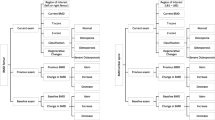Abstract
Dual-energy X-ray absorptiometry (DXA) is the most frequently performed examination to assess bone mineral density in clinical practice. Aside from images and graphical displays, many numerical values are part of DXA reports. These values are typically manually entered into the formal report through the electronic medical record or PACS workstation. The process takes time and is prone to errors. Exporting the DXA numerical data via HL7 engine to the electronic medical record was proposed to improve reporting efficiency and accuracy. The output from the DXA unit computer was reconfigured to export the report content via the HL7 interface engine into the electronic medical record. Radiology interpretive reporting was subsequently done directly in the electronic medical record. In the evaluation of errors, 100 preliminary DXA reports before the change and 100 after the change were examined. These reports were analyzed for errors that included decimal change, number transposition, negative number issue, other incorrect number error, and failure to include prior exam for comparison. In addition, report turnaround times were evaluated before and after the changes were made. Reporting time evaluations included 1-year volume prior to change (3915 reports) and 1 month post-change (206 reports). Of 100 DEXA exams before the change, 15 final reports contained 25 numerical errors. After the change, no numerical errors in the reports were identified. Exam end to final report time decreased from 2159 to 625 min on average. Automating data transmittal from the DXA modality for report generation improves accuracy and turnaround time. This approach did not require any third party software, and healthcare information security concerns were negated since we are using our standard workstations. Secondary to the affordability and applicability to the large percentage of the population using electronic medical record systems, this type of automated workflow is recommended.







Similar content being viewed by others
References
Wright NC, Looker AC, Saag KG, Curtis JR, Delzell ES, Randall S, Dawson-Hughes B: The recent prevalence of osteoporosis and low bone mass in the United States based on bone mineral density at the femoral neck or lumbar spine. J Bone Miner Res 29(11):2520–2526, 2014. https://doi.org/10.1002/jbmr.2269
Parkland Health and Hospital system. http://www.parklandhospital.com/phhs/parklands-statistics.aspx3. Health Level 7. http://www.hl7.org
Khorasani R: Can health IT tools enable improved documentation of quality, safety measures, and regulatory requirements in radiology reports? J Am Coll Radiol 10(5):381–382, 2013
Andriole KP, Prevedello LM, Dufault A, Pezeshk P, Bransfield R, Hanson R, Doubilet PM, Seltzer SE, Khorasani R: Augmenting the impact of technology adoption with financial incentive to improve radiology report signature times. J Am Coll Radiol 7(3):198–204, 2010. https://doi.org/10.1016/j.jacr.2009.11.011
Zimmerman SL, Kim W, Boonn WW: Informatics in radiology: automated structured reporting of imaging findings using the AIM standard and XML. Radiographics 31(3):881–887, 2011
Dunnick NR, Langlotz CP: The radiology report of the future: a summary of the 2007 Intersociety Conference. J Am Coll Radiol 5(5):626–629, 2008
Iv M, Patel MR, Santos A, Kang YS: Informatics in radiology: use of a macro scripting editor to facilitate transfer of dual-energy X-ray absorptiometry reports into an existing departmental voice recognition dictation system. Radiographics 31(4):1181–1189, 2011
Abujudeh HH, Govindan S, Narin O, Johnson JO, Thrall JH, Rosenthal DI: Automatically inserted technical details improve radiology report accuracy. J Am Coll Radiol 8(9):635–637, 2011
Author information
Authors and Affiliations
Corresponding author
Rights and permissions
About this article
Cite this article
Wachsmann, J., Blain, K., Thompson, M. et al. Electronic Medical Record Integration for Streamlined DXA Reporting. J Digit Imaging 31, 159–166 (2018). https://doi.org/10.1007/s10278-017-0023-1
Published:
Issue Date:
DOI: https://doi.org/10.1007/s10278-017-0023-1




